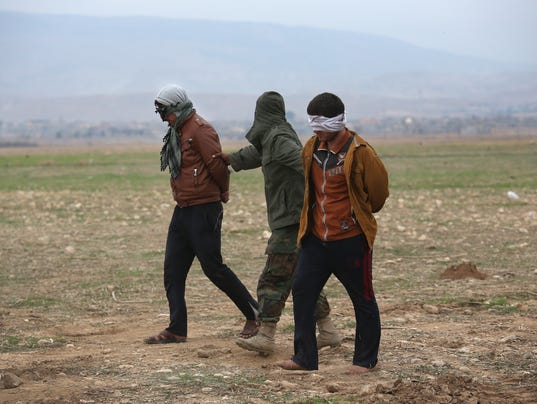Islamic State defections mount as death toll rises, U.S. official says
Defections of Islamic State fighters — a closely watched measure by officials of U.S.-led coalition — have begun to thin the ranks of the militants in Iraq in the last month, intelligence reports and drone footage show. USA TODAY
WASHINGTON — Defections of Islamic State fighters — a closely watched measure by officials of U.S.-led coalition — have begun to thin the ranks of the militants in Iraq in the last month, intelligence reports and drone footage show.
Wholesale defections, sparsely manned checkpoints and elite foreign fighters pressed into mundane duty indicate that the U.S.-led bombing campaign and advances by Kurdish forces are eroding the forces of the Islamic State, also known as ISIL, said Army Col. Steve Warren, the top spokesman for the counter-ISIL coalition in Baghdad.
Top military officials estimate that the campaign has killed 23,000 Islamic State fighters, raising their death toll by 3,000 since mid-October. Army Gen. Lloyd Austin, who oversees U.S. military operations in the Middle East as chief of Central Command, told troops last week in Iraq that the campaign is inflicting maximum pain on the enemy, according to a military official who attended the meeting but who was not authorized to speak publicly about it.
Warren cautioned that evidence of Islamic State manpower shortages was largely anecdotal. When indicators are combined, however, they show strains on the group's fighting force, he said. Islamic State fighters continues to field about 20,000 to 30,000 fighters in Iraq and Syria, and they hold key Iraqi cities of Mosul and Ramadi, and large portions of Syria.
It's also too soon to tell if apparent strain on the group is a long-term trend, said Michael O'Hanlon, a military expert at the Brookings Institution. "I view those as provisional signs of progress," O'Hanlon said. "Individual metrics like these can be deceptive, especially given the difficulty of measuring things accurately. I'd tend to agree with CENTCOM that these anecdotes and snippets of information sound promising, but just remain a bit more skeptical until we see some more indicators and see what happens when more time passes."
Near Kirkuk in the last week, 90 Islamic State fighters laid down their arms and turned themselves over to Kurdish peshmerga forces, Warren said. The former fighters were local men who had been coerced into joining the jihadists and have grown disillusioned with the cause or simply saw a way to quit the fight by turning themselves in.
The Kurds in Syria and Iraq, backed by U.S. airstrikes and advisers, have dealt ISIL blows recently on the battlefield. A peshmerga-led attack in northern Iraq two weeks ago seized the village of Sinjar, which sits astride a key highway and supply line for Islamic State forces. Meantime, over the last few days, Iraqi security forces completely surrounded Ramadi, capturing the last bridge jihadi fighters had used for resupply.
Another sign of reduced Islamic State manpower has been found at its road checkpoints, Warren said. Footage from surveillance drones shows fewer fighters manning those posts than in previous months. One result has been the ability of more civilians to escape Islamic State-held territory, he said, including a group of 22 people who recently fled Ramadi. That city has been held by the jihadists after a larger force fled without a fight.

